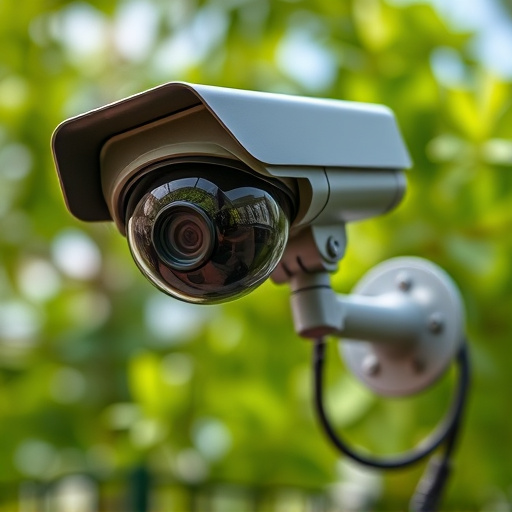This guide provides optimal mounting heights for security cameras, varying based on camera type (realistic dummy dome vs. bullet) and environment (indoor/outdoor). Indoor cameras should be 6-10 feet high, while outdoor ones range from 5-15 feet. Realistic dummy domes blend into surroundings, ideal for discreet surveillance, while bullet cameras offer superior performance with advanced features like infrared technology and more mounting flexibility at 2-3 feet above eye level. The choice between them depends on discretion preferences, installation location, and budget, tailored to individual security needs.
In today’s digital era, ensuring optimal security camera placement is paramount. This comprehensive guide delves into the intricacies of security camera mounting heights, focusing on realistic dummy dome and bullet cameras. We explore benefits, advantages, and ideal positioning for each type, enabling you to make an informed choice between them. Understanding the nuances of Realistic Dummy Dome vs Bullet Cameras allows for enhanced visibility and robust protection, transforming your space into a secure environment.
- Understanding Security Camera Mounting Heights: A Basic Guide
- Realistic Dummy Dome Cameras: Benefits and Placement Considerations
- Bullet Cameras: Features, Advantages, and Ideal Mounting Positions
- Comparative Analysis: Choosing Between Dummy Dome and Bullet Cameras for Optimal Visibility
Understanding Security Camera Mounting Heights: A Basic Guide
Understanding Security Camera Mounting Heights: A Basic Guide
When it comes to security camera placement, height is a critical factor that often gets overlooked. The ideal mounting height for your cameras depends on several variables, including the type of camera (e.g., realistic dummy dome vs. bullet cameras), the area being monitored, and local laws or industry standards. In general, placing cameras at eye level or slightly elevated provides the best field of view and coverage.
For indoor spaces like offices, retail stores, or homes, mounting cameras between 6 to 10 feet (around 1.8 to 3 meters) above the floor is recommended. This height offers a clear line of sight without capturing unnecessary details that could compromise privacy. For outdoor areas, consider factors like tree lines, power lines, and nearby structures when determining the optimal height, which may range from 5 to 15 feet (approximately 1.5 to 4.6 meters) depending on the specific camera setup and surveillance needs.
Realistic Dummy Dome Cameras: Benefits and Placement Considerations
Realistic dummy dome cameras offer a unique advantage over traditional bullet cameras in terms of security and deterrence. Their design mimics genuine surveillance equipment, providing an effective visual barrier against potential intruders. Unlike bullet cameras that may attract unwanted attention due to their distinct appearance, dummy domes blend seamlessly into their surroundings, making them ideal for discreetly monitoring sensitive areas.
When considering placement, it’s essential to evaluate the specific needs of your security system. Dummy dome cameras are versatile and can be strategically placed in various locations, from entranceways to parking lots. Their positioning should aim to deter potential criminals while providing clear coverage, ensuring a balanced approach to home or business security.
Bullet Cameras: Features, Advantages, and Ideal Mounting Positions
Bullet cameras, also known as bullet-style or cylindrical cameras, are a popular choice for home and business security systems due to their advanced features and versatility. Unlike traditional dome cameras, they offer clearer and more detailed footage, making them an excellent alternative, especially in challenging lighting conditions. One of the key advantages is their ability to capture high-resolution videos day or night thanks to infrared (IR) technology, ensuring round-the-clock surveillance.
When it comes to mounting, bullet cameras provide more flexibility compared to dummy dome cameras. The ideal positioning for these cameras is at a height that offers a clear line of sight while capturing the desired area without any obstructions. Typically, this means mounting them 2-3 feet above eye level, allowing for optimal viewing angles and minimizing blind spots. Whether installed on walls or ceilings, this placement ensures effective coverage, enhancing overall security measures.
Comparative Analysis: Choosing Between Dummy Dome and Bullet Cameras for Optimal Visibility
When it comes to enhancing security and achieving optimal visibility, the choice between realistic dummy dome cameras and bullet cameras is a common dilemma for homeowners and business owners alike. Both types offer distinct advantages in terms of appearance and functionality, making them popular choices for deterring potential intruders.
Realistic dummy dome cameras mimic traditional security camera housings, often with intricate details that make them nearly indistinguishable from real cameras. They are ideal for discreetly monitoring entry points without drawing unwanted attention. On the other hand, bullet cameras, known for their sleek cylindrical design, offer a more noticeable but robust security solution. Unlike their realistic counterparts, these cameras do not attempt to blend in; instead, they assertively convey their purpose as deterrents. When deciding between the two, consider factors like installation location, desired level of discretion, and budget. The choice ultimately depends on individual preferences and specific security needs, ensuring either option effectively contributes to a comprehensive surveillance system.
When selecting security camera mounting heights, understanding the unique features of different types like realistic dummy dome or bullet cameras is key. Each has its own advantages and ideal placement strategies. For areas requiring unobtrusive yet effective surveillance, realistic dummy dome cameras offer a subtle solution with proven benefits. On the other hand, bullet cameras excel in providing wider fields of view and enhanced visibility, making them suitable for broader security needs. By carefully considering these options and their compatibility with specific locations, you can make an informed choice between Realistic Dummy Dome Vs Bullet Cameras to ensure optimal security coverage.
